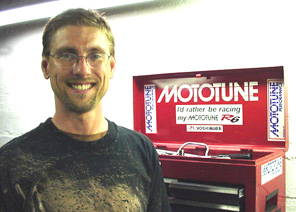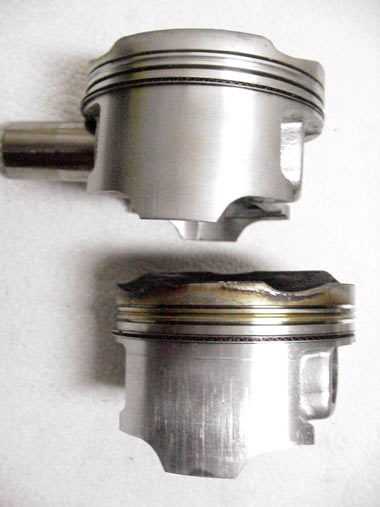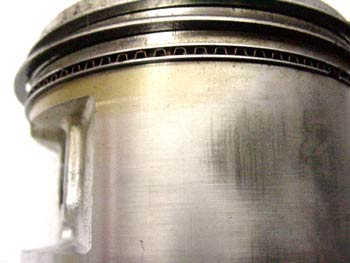
![]()
" Thinking the
Un-Thinkable "

Presents:

Future Horsepower
(Where Will It Come From ??)
|
|
|
MotoMan:
Call me a major skeptic but all these claims of more power ... yada ...
yada,
and not one of the posters has dyno charts. If you want to be taken
seriously, then some concrete data is in order.
~ Matthew
Hi Matthew !!
Thanks for your feedback !
There were 2 dyno sheets showing the power increases of high velocity porting in the
first porting article entitled "Think Fast". (All the past issues are at the very
bottom of every Power News article.) Dyno charts are interesting, but real world results
(actual use on the road & track) from real
people are far better evidence. That's the only way to decide how well
these modifications work ... in the venue that they're meant to work in.
I'll take your advice and
add a mix of both types of evidence as it comes in. Keep on reading Power
News ... I promise that you won't be disappointed !
Sincerely,
Pat McGivern
~ MotoMan
|
ABOUT POWER NEWS: As with any information source, only you can decide which ones
are trustworthy. Critical reading and thinking are by far the best ways to separate the baloney from the real deal. |
Breaking News:
Power News Subscriber Wins European 600 Supersport Championship
Using High
Velocity Intake & Exhaust Ports !!
|
|
Norway's Kai Børre Andersen dominated the European
supersport championship this year with 4 wins out of 8 races. The points
total tells the story: KBA finished with 153 points, and the second place
rider had 93 points... ! Despite winning the championship with 1 race to go, Kai Børre went on to finish the last round with a resounding 6.5 second win in Cartegena, Spain !! Kai Børre's 'secret weapon' ?? His Yamaha R6's unique engine set-up features smaller than stock, High-Velocity intake & exhaust porting by Jørgen Johnsen of Fast Bikes http://www.fastbikes.no in Oslo !! Congratulations from all of us at Mototune USA !! Read all about it in MC Avisa: http://www.mc-avisa.no/default.asp?aid=4096 (in Norwegian) |
Wait a minute ... what just
happened ???
Now you know the real "
inside-the-motor " tuning secrets of
an
International Championship winning machine !!
When has a motorcycle magazine revealed actual
internal engine secrets of
racing at this level ???
Of course the answer is never ...
it just doesn't happen !!!
Power News is your inside source !!
{ Please recommend Power News & tell your friends to
sign up !!
}
P O W E R V O T
E !!
World Supersport VS
Power News
Who Do You Think Won The Test ??
|
|
|
|
The Results:
92 % Voted that the Power News High Velocity ports made more
power.
8 % Voted that the World Supersport ports made more power.
Cognitive Dissonance
Psychologists know that when people are confronted by information
that
goes against their pre-existing ideas, the result is cognitive dissonance, a sort
of "static" in the thinking process. It doesn't matter how smart a person is ... cognitive
dissonance occurs in highly intelligent people !!
When someone receives information that is opposite to what they think, cognitive
dissonance can discredit that information, so that the person won't seriously
consider it. In fact, if a new idea drastically opposes one's previously held
ideas, the threatening info won't enter their consciousness at all !!! The idea
becomes simply 'unthinkable' that it could possibly be true, even with things that
are totally obvious to an outside "impartial" observer.
Cognitive
dissonance is a primitive, yet amazingly powerful self-preservation
mechanism which can completely override the natural human desire for truth !!!
It's also the main reason that it's so hard for some to re-think new ideas about
how horsepower can be achieved.
Here's a real world example:
Many years ago an engine builder bought an engine from one of my customers at
the end of the race season to find out why it was so fast. There it was: high
velocity (smaller than stock) ports and there was no way I could hide the secret
from my competition any longer.
Needless to say, I wasn't too happy about it.
To my surprise... after seeing the inside secret to my customers
success, seeing the race wins and seeing
high speed of the bike, the engine builder refused to see
that smaller ports worked, and refused to even try it. That's the incredible
power of cognitive dissonance !!
/
|
|
Cognitive Dissonance = "The Box" |
High Velocity Ports Beat The World
Supersport Porting By 5.8 Horses !!
1 2
2 3
3
4 5
5
 (.8)
(.8)
Seeing it in actual "Horses" really makes the
picture clear .... that's a
lot more power !!!
The World Supersport ported motor made 114hp, while the Power News High Velocity
ported motor made 119.8 HP, for a gain of 5.8 "Horses" !!
In the last issue I described the drive to the dyno, and how nervous I was that
the engine I ported wouldn't beat the World Supersport ported engine. Why should
I have been afraid ?? Smaller ports on the R6 perform better than stock
ports do ... so how can bigger than stock be better ??
Of course, they're not.
My nervousness had nothing to do with the facts ... it's just that the ominous label "World
Supersport"
gave the MotoMan a severe case of Cognitive
Dissonance !!! ![]()
![]()
![]()
Breaking News:
Power News Subscriber Wins Norwegian 600 Supersport Championship
Using High
Velocity Intake & Exhaust Ports !!
|
|
Komatsu Sundby
Racing
Wins The 600 Championship & The Coveted King's Trophy !! Våler, Norway -- Defending Norwegian 600 Supersport Champion Dag-Steinar Sundby has repeated his 2001 championship in a stunning way !! In the wet race final round at Våler Raceway, the veteran Sundby fended off tough challenges from his hard charging countrymen Even Flaat and Espen Rekedal Wæhler to win the race, the championship, and the King's Trophy as well. In Norway, the King's Trophy is awarded once every 5 years in the sport of roadracing, so it was an extra special weekend for the team ! Dag-Steinar did it with a unique "out of the motorcycle industry" sponsorship from Komatsu Construction & Mining Equipment and engine tuning featuring smaller than stock, High-Velocity intake & exhaust porting byJørgen Johnsen of Fast Bikes http://www.fastbikes.no in Oslo. Dag-Steinar and his hard working crew represent a new wave of roadracing teams which are taking the sport to a higher level !! Congratulations from all of us at Mototune USA !! |
|
Dag-Steinar's success
is huge news for the sport of Motorcycle Roadracing !! |
|
Break In Results From Forums and E-mails
!!!
The break in secrets article is quite controversial, since it "breaks all the rules".
But, the people who have actually tried it
have found
amazing
gains in power, from better ring seal ...
Does It Work ???
2002 Yamaha R1
Hey, you guys want to know the secret to getting more HP's go to
www.mototuneusa.com
look for the break in procedure. This is how I did my 2002 Yamaha R1 on a Sunday morning
with no traffic. I go 136 HP and my buddy only got 131 HP.
Disappointed 2002 Yamaha
R1 ...
Just had my 2002 Yamaha R1 Dyno'd
1,350 miles. Followed the
owners
manual break-in and
got 124.5 HP. I thought it should have more
than that, is there anything I can do ??
Does It Work ??? Aprilia Mille
I thrashed the hell out of mine from day one
(Once totally warm). It hasn't used any oil and throttle response is definitely
crisper than friends who bought there new Milles at the same time as me. Follow
the procedure here found on this website and you can't go wrong. Scroll down
till you get to the bit about "Break In Secrets".
www.mototuneusa.com
Disappointed
Aprilia
Mille
I ran mine in by the
book [according to the owner's manual] , and found it used quite a bit of oil up
to about 5000 miles. Apparently this was cause I ran it in too gently, and a
gentle thrash every now and then during running in results in less oil use
later.
Does It Work ??? Yamaha R6
I used the Mototune USA break in procedure on my Yamaha R6 and I'm getting
about 105hp.
Very pleased after I saw the same bike with the same mods (stock engine) do less then 100hp on the same dyno
!!
Does It Work ??? Suzuki
Yes, I used it for my TLR, my TLS, our SVS, and my cousin's Telefonica 600
GSXR. No problems on any of them...My dealer even recommends this
procedure to his GOOD REGULAR customers.
Does It Work ??? Suzuki
Hi MotoMan:
I read your story about "hard" break in of motorcycles. I can do
nothing else than agree to your suggestions. My three latest bikes (all
Suzukis TLS, TLR and now a GSX-R1000) has gone through what you describe
to be the best break in and in all three cases my bikes have worked better
than my friends' have, and in one case the difference was so big that we
decided to [Dyno] bench the bikes. The difference ended up to be 9 hp to
my advantage. Of course a lot of things can affect to give such a
difference, but nevertheless my bike came out better than his which had a
"owner's manual" break in.
Does It Work ??? Honda
Hi MotoMan,
Loved your article on break in, I have always run my new bikes in hard
with no problems, your information helped me understand why, so thanks
for that. I totally agree on changing the oil after the first few miles
in fact I go even further than your suggestions as after only 15 Miles I
change and
flush the oil multiple times until the moon dust sheen is eliminated from
the top of the oil.
I picked up my new [Honda] 954 Blade last Tuesday and run various
acceleration
and deceleration cycles on the road for 15 Miles only and changed the oil
and filter, with heavy deposits of aluminum particles floating on top of
the
oil it needed it, it took three complete oil flush cycles until the oil
drained clean, I then add a second filter after the final oil change.
Sounds expensive and wasteful but I am convinced it will be the cheapest
performance gain I will ever find.
~ Andy
Hi Andy,
Thanks for your response !
As you've discovered, it's definitely important to change the oil waaaaay
sooner than the 600 miles that the manufacturers recommend !
Much of the metal that comes loose in a new engine isn't directly
from the break-in process, but rather it's from the aluminum burrs that
break off from the edges of the machined surfaces.
The manufacturers won't tell us that,
because it looks bad. But realistically, it's not possible to mass produce
machined parts and de-burr the hundreds of parts in each engine by hand.
The best thing we can do is to
understand the
situation and flush the bits out with an extra early oil change (or 2) !!
~MotoMan
"Break In Secrets" Part 2
Hi MotoMan:
I offered up a link to your break in secrets web site on a bulletin board
(Motorcycle tech board), and below is a copy of a response offered up by someone
who is writing about you. I would sincerely love to know what your reply to this
is. Thank you !!
(MotoMan's comment: I
don't usually like the idea of debating against someone on Power News, because
doing so is bound to make that person's comments appear "wrong", and
put him on the defense. In this case, I decided to make an exception, because
it's a valuable opportunity for us to practice critical reading and thinking.
Before you read my response to this post, take a moment to see if you can find
some problems with it.)
|
I abhor opinions presented as fact. Everyone has an opinion, but that doesn't mean there is not THE truth somewhere underneath, independent of opinion. I wrote my thesis in physics on internal combustion engine design and I have been a mechanic building high-performance engines for 30 years. This discussion about break-in has no empirical data to support what he is saying. Blanket statements such as the "number one cause" of this mechanical problem, or the "number two cause of engine problems is" are meaningless unless he can present test data and empirical data to support these statements, which he cannot and does not. The reason he does not is because the statements are false (ie his opinion, stated as fact). The reason you want to run an engine softly for the first 600 miles is because of machining asperities (the microscopic "mountain ranges" on the surface of the metal). After a part is machined, the cutting process involved leaves the surface with microscopic peaks and valleys, creating a microscopically rough surface. The peaks of this surface happen to be GREATER IN HEIGHT THAN THE THICKNESS OF THE OIL FILM COVERING THEM. In English: the engine must be run with minimum load until these peaks are polished down, flat, and are no longer PROTRUDING THROUGH THE SURFACE OF THE OIL, as they are right after machining/manufacturing of the part. If you run the engine hard before this happens, you will press the parts together so hard that the oil film collapses and the peaks on one part will collide with the peaks on the mating part: Peak on part A will hit peak on part B, and given the adhesive properties of superheated metal, they will stick together. Once this happens, peak A breaks off of its original part and bonds to (melts onto) the mating part, and you now have scoring. Once scoring starts, it will continue to increase (more metal from one part sticks to the other part) until (a) enough metal migrates from one part to the other to cause a new smooth surface (albeit the wrong shaped surface; ie greatly reduced seal in the case of pistons and rings) or (b) the part suffers catastrophic failure (eg engine seizes, part cracks, etc.). If the engine is run softly, the parts polish each other, rather than score each other. This explanation of break in is common text in ANY mechanical engineering text book, which is the book the engine designers read before they built the engine, and the text, in turn, is based on testing and empirical data that began back before the Wright Brothers. Interestingly, the most prolific testing and proving of how to best build and break in a fresh engine came during World War II, for our bomber engines, where engine performance determined whether our nation would continue to exist. There is enormous test and research data supporting what I just told you regarding break in. Run the motor at modest throttle settings and slow to medium rpm until 600 miles, and then change the oil and filter to get the polished metal out of the engine. |
It's true, Power News is just my
opinion.
But, an interesting question is:
When does an opinion cross the line to become a
fact ??? Usually, that only happens when an "Official
News or Information Source" says so. The second way a fact can be
established, is when a lot of real people confirm it. This has a lot
more credibility. (in my opinion).
Mototune power tuning ideas are now being tested and
confirmed by a large number of real people. In the past one and a half years, Power News
subscribers have now grown to over 10,000 readers from just about every country in
the world. 'Opinions', are now in
the process of becoming 'recognized facts'.
With all due respect to the
gentleman who posted his comments ... there are 2 important problems:
1) It's based on old information.
2) It doesn't test
both
break in methods to draw an accurate scientific conclusion.
|
Modern engines
have changed dramatically ! |
|
In other words:
One of
the conditions
of the "experiment" has changed
!!
It's critical that we recognize this, since it's really the heart of the scientific
method !!
For example: 1+2+3 always equals 6
but
when we change one of the conditions, let's say 2 is now 7 ....
then 1+7+3 doesn't = 6, it equals 11.
When we see it put this way it's obvious, but how does it apply to break-in ???
(The condition of the "break-in experiment" that has changed is: vastly improved technology ! )
 |
If you hang onto "what
is" with all your might, |
Power News:
" The World's First Cutting Edge
Engineering Text Book "
According to the information
contained in older engineering textbooks, every one of the riders who've used
the Mototune USA break in technique should be making
less
power from all of the engine damage caused by machining aspirants breaking through the oil film.
Scuffed and partially seized parts would create a lot of extra friction !!!
Yet everyone is making
More
power.
There Must Be More To This Than
Meets The Eye ...
Here's an Interesting Story
About The Development of Modern Logic:
During the "dark ages", the dominant way of thinking was known as Aristotlean Thought.
Named after the
Greek philosopher Aristotle (384-322 BC)
Basically it went like this:
|
You don't look into an
individual horse's mouth |
|
As you can imagine, this early
form of logical thinking is what made the dark ages so long
and ...
... so Dark !!!
Modern thought is superior
because
In order to make a truly scientific judgment, you must observe:
|
To
accurately
count
it's
teeth,
|
|
From that concept,
The Scientific Method
was born:
Observe
one
set of conditions. Make only one
change. Observe
the result
and compare
it to the first set of conditions.
Using the scientific method, we
can observe
the effects of both break in methods
on modern engine parts. Just like back in the "Dark Ages", without testing
both break in methods,
we are only debating about it !!
Let's Open The
"Horses Mouth":
|
To Look At The
'Horses Teeth' !! Bottom: |
 |
It's interesting to note that the piston from
the engine that's making more power is in much better condition than the one
making less power. That's the whole point ! There is a
connection
between power and reliability. Power comes
from the engine running correctly, without extra friction caused by poor
cylinder seal and cylinder distortion. Ironically, it's just the opposite of
what one would think ... without fully thinking through what's really
happening inside the engine.
That's why it's so important to: "Always
Consider The Opposite".
(One of
the best ways of learning to think outside the box.)
Here's another example from a street bike:
|
This piston is from a 650 Honda
Hawk. The brown discoloration that extends up into the piston pin bore
is burnt oil from the extreme heat leaking past all
3 rings !! |
 |
The next series of 3 photos are from a
1999 Yamaha R6 engine that
had my
recommended " hard break-in "
... was broken in with 'cheap' non synthetic Valvoline 10w40 car oil...
... then it was roadraced hard for 2 full seasons and over 10,000 racing miles !!
|
Machining Asperities
|
|
|
Oils and oil delivery methods have improved
dramatically ... |
|
|
|
|
This feedback came from an automotive forum:
I read
this article by a motorcycle tuner
http://www.mototuneusa.com
(offline as I speak) which recommended
breaking in pretty hard. The point was bearings don't really break in as they are
designed to ride on film of oil, and it is disaster if there is metal to metal
contact. On the contrary, rings bed in against a honed cylinder surface, and the
pressure is supplied by the combustion gasses which push out from the back of
the ring. Running it hard before the honing wears off assures better fitting of
the ring to the bore, better sealing, more power. Going easy is
counterproductive. Just what I read, and it makes sense to me. The
factory does not supply a rationale for doing it their way.
This post highlights a
key
point ....
What is the factories' rationale for doing it their way ???
Here's a fascinating "open
secret" ...
Did you know ??
Many visitors to the motorcycle factories in Japan have been surprised to learn
that ...
the first time they start up the bikes at the end of the assembly line,
the workers warm the engines up,
and then they rev them waaay up ... ... right up to
R E D L I N E
!!!
Why ???
One reason they do this is for a final check on the bike, but that can be done without going over 4,000 rpm.
Why do they blast them hard waaaay up to 10,000-14,000 ??
( SSshhhhh ... it's a secret ....
don't tell anyone .... it's to start the ring sealing
process !!!!!)
The Big Question:
After running your brand new bike right straight up to the rev-limiter,
doesn't it seem strange that the very same manufacturers recommend not going
past 4,000 rpm to avoid
severe engine damage to your new engine ??
In other words:
" How can you wreck your motor from high rpm's after ten miles, when the
manufacturers couldn't wreck it from hitting the rev-limiter at zero miles ??
"
" I think something's up !!! "
|
|
######################################
|
To figure out what's really
going on, we must tune out the various emotional distractions and take a good,
objective look at all the evidence !!
Cognitive Dissonance is the biggest
barrier to this, because we'll never get to the point
of understanding, if we can't get past thinking:
"That's the way it's always been done
... "
Or Especially:
" The manufacturers must know best "
How much time ...
... do you think the motorcycle
manufacturers spend thinking of ways to avoid
unfair lawsuits that take
large chunks out of their hard earned profits?
One of the best ways to avoid
lawsuits is to avoid accidents in the first place ! It stands to reason that
the first miles on a new and unfamiliar bike are the most likely
to produce an accident.
Conveniently, this same period of time is also
known as the "break in period"
.
![]()
![]()
![]()
![]()
![]()
![]()
![]()
![]()
![]()
![]()
![]()
![]()
![]()
![]()
![]()
![]()
![]()
![]()
![]()
![]()
![]()
![]()
![]()
![]()
![]()
![]()
![]()
![]()
"Connecting The
Dots"
Nowadays, "Break-in according to the manual" has nothing to do with the engine
!!
Think: It's all about avoiding lawsuits from riders
who have crashed their
new bikes !!
(The motorcycle manufacturers simply don't trust
you to use your own judgment.)
By using the threat of severe engine damage, new riders are scared into
riding slower
as they get used to their new bike.
Fear
is a powerful motivator. More people have their thoughts and actions
controlled
by
fear
than by any other source.
Ironically, leaky rings cause combustion
blow-by, which is high in acid content. These acids contaminate the oil, and are harmful to
all internal engine parts. "The owner's
manual break in" actually increases the amount of acid circulating throughout the
engine !!
Think: If engines lasted longer there would be
fewer sales of parts, service and
of course ... new bikes !!
|
|
Thinking out of the box allows you to see that there's often a huge difference
between the "official" reason and the
real reason for
things. |
What's The Opposite of Thinking Out Of The Box ???
Automatic
Thinking !!
|
.
. . . . . .
. |
" If you would be a real seeker after
truth, it is necessary that at
least once in your life you doubt, as far
as possible, all things. "
~ Rene Descartes -- 17 th Century Philosopher
" Thinking outside of the
box means that you've got to
doubt as far
as possible, all things, on a
regular basis, and
believe all things, as far as possible, just as often. "
~ MotoMan -- 21 st Century Philosopher
Thanks To

Readers
For Helping To Make

#1 !!
|
|
|
Smaller Ports on Harley Davidsons ??
Yo
MotoMan:
I've been reading your e-columns for a while with some considerable amusement. I'm finally compelled to write because of the reference in your latest issue to Harley-Davidson motors & the question of whether small ports would work in that application.
I road-race a Buell which,
of course, is fitted with a H-D Sportster motor which comes with upgraded heads,
cams, pistons. In stock tune it
delivers approx. 85 h.p. and 80 ft/lbs of torque at the rear wheel. Virtually
ALL Harley race tuners use typical small-block Chevrolet NASCAR-type technology
to build race motors on this platform (read: BIG cams, BIG ports, LOTS of
squeeze). They then spin the motors
at 8,000+ rpm to make it all work. Bearing
in mind the H-D V-twin motor is basically an over-sized air compressor, the
results are predictable: manifestly unreliable motors which struggle to keep up
with Ducs, RC51's, etc., etc. They
typically make 110 h.p and 90 ft./lbs. of torque (rear wheel) with very narrow
power bands.
After a 2 season alliance with a local Harley dealer (with a lot of racing experience) resulted in nothing but innumerable broken parts (including one spectacular exit of a con rod through the transmission resulting in a lurid rear wheel lockup and slide for a couple hundred ft. but, Hey!, I didn't fall down..) and major expense, I went looking for a different solution. I found it in the person of a Mr. Bob Johnson of J.E.T. in Westerly, Rhode Island. He has a fascinating background in leading edge automotive head design, but currently does only one-off customer engine projects, both bikes and cars.
To make a long story short, Bob built a new race motor for my Buell based on his research and applied mathematics to produce the best port velocity and cylinder-fill characteristics, i.e. small ports. In fact, his research, and empirical testing reveals that the most powerful cylinder head Harley makes (regardless of engine size) is their "little" 883 head. He has made 100 h.p. in testing by simply bolting (with some minor modification for fitment) a set of 883 heads on a big twin (1340) motor with appropriate cams.
And now the BIG QUESTION: how does my motor work???? At 10.1:1 compression, Red shift 567 cams, 44CV carb, modified intake manifold (to straighten the runners out), the puppy makes (rear wheel) 108 h.p, @ 6800, 100 ft./lbs. of torque @ 4500. 86% of max torque is available between 3,000 and 6800; the acceleration curve of the motor is nearly vertical, oil temp never exceeds 150 degrees, it runs on pump gas. Not a single mechanical failure. The bike pulls like Jack-The-Bear, blowing off Ducati's, Hondas, Suzuki's, everything in the class. We have so much torque available (and THAT'S what moves the bike, not h.p.), we're considering replacing the 5 spd. Trans with a 4 spd. I really only need 3 race gears and a low for the pits/start line. The bike is much easier to ride fast because the torque is available everywhere and is smoothly predictable, unlike the typical H-D race motor which is tuned to produce h.p. waaay up in the corner of the power curve.
Bob calculates there's another 10 rear-wheel h.p.
in the motor by going to even smaller ports (I presently am running 1203
'Thunderstorm' heads modified by Bob to shrink the ports) with 883 heads and
more cam, but the power delivery would be more radical and would probably
require a slipper-type clutch to be rideable (due to
deceleration compression). I haven't
gone that extra step simply because I don't need any more power!! (Imagine
that!).
Sooooooo
MotoMan ???
The answer is, YES small port technology works on
two valve motors, and specifically H-D motors !!!
Hope you find this interesting
Cheers !!
~ Robin
---------------------------------------------------------
Hi Robin !!
Thanks for the incredibly encouraging info, I'm suddenly
starting to turn
"orange and black" !!! I want to work on some Harleys !! Look for more
info in upcoming Power News issues about the mighty V Twins from Milwaukee !!
~MotoMan
The Super Glue Trick
Here's a funny situation ...
"The Super Glue Trick" was one of the first newsletters, and since it
came out I've been told by many medical professionals that " You can't do that
!!! " .... "Super Glue is for gluing things together ... it says right on the label not get it on your skin....
can't you
read ?????? "
My answer has always been, "why not ??" It never hurt me, and it works
better than anything else I've found for fixing cuts that are common while
wrenching on engines. I wouldn't give Super Glue to a small kid to play with,
but we're all adults here.
So,
I was very
Dear MotoMan:
Were you aware that super glue was designed by the military? I think it was
during the Vietnam war. Super glue was developed to mend wounds in the field
where many soldiers die from loss of blood. The problem was that by the time it
was developed, the war was over. So they had to find a different use for it.
Super glue bonds many things but what does it bond the best instantly? That's
right SKIN !!!
~ Lion
Dear Lion:
Wow !!
So, this means that by thinking out of the box, I discovered a use for something
that was undoubtedly invented by thinking out of the box, and re-marketed for
another use, by yet another out of the box thinker. Although " in the box
" thinkers have said that it can't be used for the purpose that I thought
out of the box about, it turns out that the product was originally intended for
the very same use.
Can this be real ???
~ MotoMan
Hey Motoman!!
Love your web site!!! I especially liked the Super Glue Trick. In fact I
work at a hospital and I asked one of the ER docs about it and he said
they already have it. They call it "liquid stitches" and the trade
name is Dermabond.
They especially like to use it for face cuts etc.. where you wouldn't want a bad
scar to
form.
Of course it's not available to the public, because you have to be a
"professional" to use it.
Here's the catch: It's exactly the same ingredient as used in super glue ....
Cyanoacrylate !
It is super glue, just in a different package. How bizarre.
Thanks again for the "Out of the Box" thinking techniques. You've
really
made my life more interesting.... Keep on empowering people !!
~Ambulance Chaser
Hey Ambulance Chaser,
Thanks for the awesome info !!
Can you imagine a doctor telling you he was going to use "Super Glue"
to fix your cut ??
No way !! But.... if it's "called" something else, than it's
o.k.
This makes me wonder.... why do people have such a deep-seated need to be
deceived ??
Here's another "out
of the box" thought:
Does the Cyanoacrylate
used in "Dermabond" cost more than the Cyanoacrylate
that's used in
"Super Glue" ??
(Of course not, it's exactly the same thing.)
I'd be willing to bet that "Dermabond" costs waaaaaaaaaaaaaay
more than "Super Glue".
~ MotoMan
|
|
#################################### |
The Exhaust Pipe Trick
Since the "Dynamic Horsepower" and "Dynamic
Aerodynamics" Power News articles came out last year, there have been 2
interesting developments !!
In these articles,
I used a photo of Eric Bostrom's Kawasaki superbike to show that even
the
factory teams don't always get it right.
|
Have Eric's mechanics secretly signed up
for Power News ??? |
|
The Second Development:
Yoshimura now incorporates this concept on their newest exhaust systems !!
|
|
This is the Fast Bikes
Suzuki GSXR 1000 Superbike at the Arctic Circle Raceway in Norway. |
I'm honored to see these top teams
incorporating Power News ideas into their tuning. Eventually as competition
forces the other exhaust manufacturers to incorporate this idea into their
systems,
there won't be any more bikes losing horsepower and disrupting their
aerodynamic efficiency from exhaust gasses that are
" blowing in the wind ".
The real interesting thing is that since these 2 "official sources"
have decided that it's a good idea, we're seeing what began as an
"opinion" .... has now become a "recognized fact".
A Philosophical Question:
Was "the exhaust pipe trick" a fact before it was recognized as a fact
??
Or ... as I like to think:
.
MILLIONS of years ago, before us humans were
here to think about it,
wasn't the exhaust pipe trick actually a fact,
" waiting to be discovered by out of the box thinkers " ??
|
|
" Future
Horsepower " |
.
.
|
|
What if we were to develop
a conscious desire to explore possibilities outside of our conditioned
thinking ??? |
Coming up in the next issue of Power News:
|
Learn How to Do it Yourself:
Smaller Intake Ports Gain 7 % More Power
|